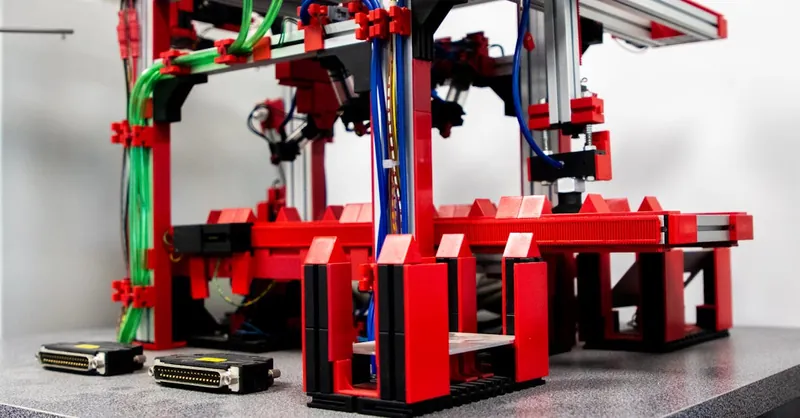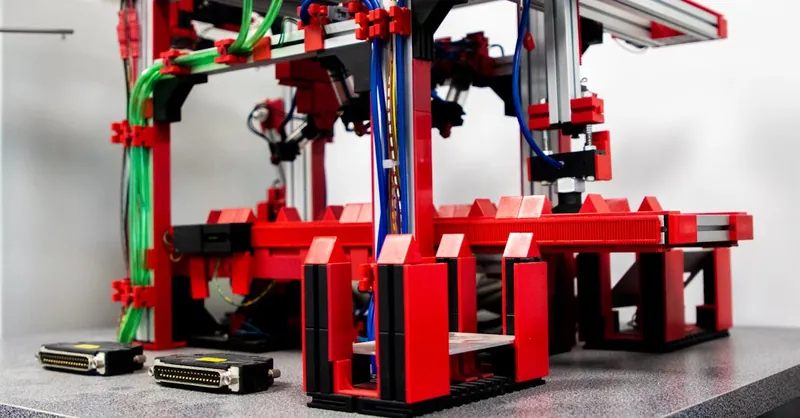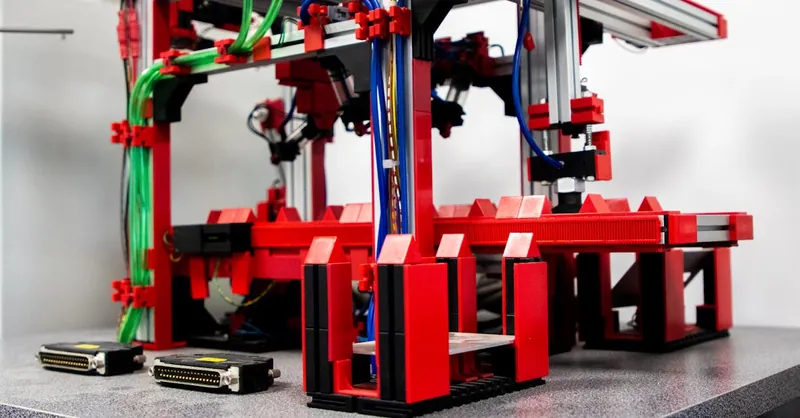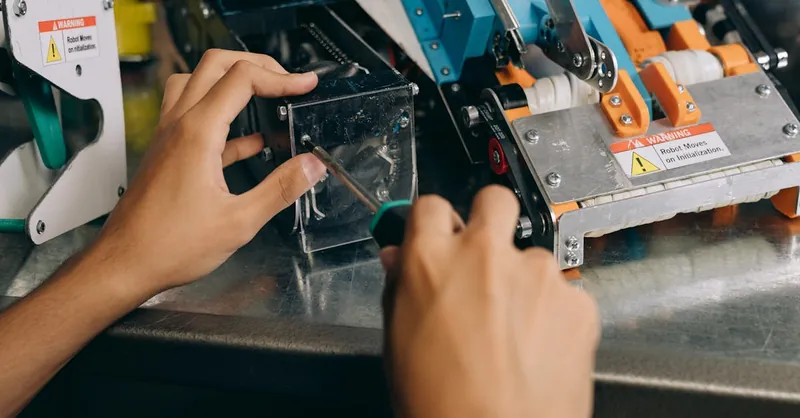Boost Daily Work Efficiency Using Robotic Process Automation
Category: Productivity & Automation
Transform Your Daily Workflow with Robotic Process Automation
If you’re a professional, entrepreneur, or tech enthusiast struggling to keep up with repetitive daily tasks, this guide on using robotic process automation (RPA) in daily work is designed just for you. Chances are, you already know the immense potential automation holds, but finding the right practical steps and insights to integrate RPA into your routine can be overwhelming. Whether it's managing data entry, streamlining approvals, or automating email responses, RPA offers a way to reclaim your time and focus on what truly matters — strategic growth and innovation. In this article, we cut through the jargon and surface proven strategies and workflows that you can apply right now, backed by real-world examples and expert tips. You’ll gain clarity on how to identify tasks ripe for automation, choose suitable tools, and measure productivity gains effectively. This post stands apart by focusing on actionable insights tailored for busy professionals eager to leverage AI-powered automation daily, not just theoretically but practically. Dive in to find out how you can tame task overload, minimize human error, and supercharge your productivity with robotic process automation.
- Transform Your Daily Workflow with Robotic Process Automation
- What is Robotic Process Automation? Defining Core Concepts and Key Benefits for Professionals
- Identifying Daily Tasks That Benefit Most from RPA
- Top RPA Tools for Daily Work: Overview of Leading Platforms and Software Designed for Everyday Automation
- Step-by-Step Guide to Implementing RPA in Your Daily Workflow: Practical Approaches from Planning to Deployment
- Integrating RPA with Existing Technology Stacks: Ensuring Seamless Connectivity with CRM, ERP, and Other Software
- Overcoming Common Challenges and Pitfalls in RPA Adoption: Tips for Troubleshooting and Continuous Improvement
- Measuring Success: KPIs and Metrics to Track Productivity Gains from RPA in Daily Tasks
- Advanced Use Cases: Combining RPA with AI and Machine Learning for Smarter Automation
- Enhancing Team Collaboration and Workflow Optimization through RPA
- Future Trends in Robotic Process Automation and What They Mean for Daily Work Productivity
What is Robotic Process Automation? Defining Core Concepts and Key Benefits for Professionals
Robotic Process Automation (RPA) is a transformative technology designed to automate repetitive, rule-based tasks traditionally performed by humans. Unlike physical robots, RPA software bots interact with digital systems by mimicking the exact actions a human user would take—such as logging into applications, copying and pasting data, filling out forms, and processing transactions. By leveraging these software bots, businesses and professionals can streamline workflows, improve accuracy, and free up valuable time for higher-impact activities.
At its core, RPA enables organizations to automate routine processes without altering existing systems or requiring complex integrations, allowing quick deployment and scalability. For professionals juggling multiple responsibilities, this means less time spent on mundane tasks like data entry, invoice processing, or report generation, and more focus on strategic priorities.
Key Benefits of RPA for Today’s Professionals:
-
Increased Efficiency and Speed
Automating repetitive tasks reduces processing time drastically, allowing projects to progress faster and deadlines to be met consistently. -
Enhanced Accuracy and Reduced Errors
Bots follow predefined rules rigorously, minimizing the risk of human error which is common in manual data handling. -
Cost Savings and Resource Optimization
By decreasing the need for manual labor on routine activities, RPA significantly cuts operational costs and allows professionals to allocate resources more effectively. -
Scalability and Flexibility
RPA solutions can be scaled up or down according to workload demands, giving teams the flexibility to handle fluctuating volumes without strain. -
Improved Compliance and Auditability
Automated workflows create detailed logs for every action performed, facilitating easier compliance checks and audit trails.
Understanding these core concepts and tangible benefits sets the foundation for effectively integrating RPA into daily work routines. As we explore practical approaches further, you’ll see how these advantages translate into measurable productivity gains and overall business growth.

Image courtesy of Pavel Danilyuk
Identifying Daily Tasks That Benefit Most from RPA
To unlock the full potential of Robotic Process Automation (RPA) in your daily workflow, the critical first step is pinpointing which tasks are ideal candidates for automation. Generally, RPA excels in handling repetitive, rule-based activities that require minimal human judgment but consume significant time and cognitive resources. These tasks are often high-volume, standardized, and governed by clear procedures, making them perfect for software bots to execute consistently and accurately.
How to Spot Tasks Suitable for Automation
Consider your daily routine and look for processes that exhibit the following characteristics:
-
Repetitiveness: Tasks you perform frequently with little variation, such as copying data between systems, sending routine emails, or generating standard reports.
-
Rule-Based Nature: Activities governed by explicit, logical rules—no decision-making based on ambiguity or complex problem-solving. Examples include invoice processing according to fixed criteria or approval workflows based on predefined thresholds.
-
High Volume and Standardization: Work involving large quantities of similar transactions or data entries that follow a consistent format.
-
Manual Data Handling: Tasks that require transferring information across multiple platforms or applications manually.
-
Prone to Human Error: Routine jobs where mistakes are common due to monotony or information overload, such as transcription or form filling.
-
Time-Consuming but Low Value: Processes that take up significant time but add limited strategic value, which can instead be reallocated to focus on innovation or complex problem-solving.
By regularly auditing your daily activities against these criteria, you can efficiently identify repetitive, rule-based tasks ready for RPA implementation. This targeted approach not only ensures smoother automation deployment but also maximizes productivity gains by freeing up your time to concentrate on high-impact work. Examples of such tasks include:
- Data entry and migration
- Employee onboarding procedures
- Email and calendar management
- Invoice and purchase order processing
- Routine compliance checks and audits
Mastering the art of spotting automation-worthy tasks is foundational to leveraging RPA as a powerful productivity booster in your professional life.

Image courtesy of Ludovic Delot
Top RPA Tools for Daily Work: Overview of Leading Platforms and Software Designed for Everyday Automation
Selecting the right Robotic Process Automation (RPA) tools is crucial to ensuring seamless integration into your daily workflow and maximizing productivity benefits. Fortunately, the market offers a range of powerful, user-friendly platforms tailored to automate repetitive tasks efficiently without requiring extensive coding knowledge. Here’s an overview of some of the top RPA tools ideal for everyday professional use:
-
UiPath
Widely regarded for its intuitive drag-and-drop interface and robust automation capabilities, UiPath enables professionals to automate complex workflows across various applications—from Excel macros to web scraping. It supports both attended and unattended automation, making it versatile for personal daily tasks as well as enterprise-level operations. UiPath also offers extensive documentation, community support, and AI integrations, making it a go-to choice for boosting individual and team productivity. -
Automation Anywhere
This platform combines RPA with cognitive elements like natural language processing and machine learning, providing intelligent automation that adapts to dynamic tasks. With Automation Anywhere’s user-friendly Bot Creator, professionals can automate frequent activities such as data extraction, email management, and report generation without deep technical expertise. Its cloud-native design supports scalability and remote workforce automation, ideal for modern, distributed teams. -
Microsoft Power Automate
Formerly known as Microsoft Flow, Power Automate is especially attractive for users embedded in the Microsoft 365 ecosystem. It offers seamless automation of tasks across Outlook, SharePoint, Teams, and other Microsoft services, enabling effective email automation, approvals, and data synchronization. Power Automate’s low-code environment allows non-developers to build automated workflows quickly and integrate with hundreds of third-party apps. -
Blue Prism
Blue Prism is a pioneer in enterprise-grade RPA and suits professionals aiming for more control and security in automation. It emphasizes robotic workforce management, auditability, and governance features, which are essential for compliance-sensitive industries. While it may require more initial setup, Blue Prism delivers scalable and reliable automation for high-volume transactional processes and complex multi-system environments. -
Kryon Systems
Kryon stands out with its unique full-cycle automation approach that includes process discovery, analytics, and deployment. This makes it easier to identify automation opportunities and continuously optimize workflows. Its user-centric design caters well to professionals seeking to automate both routine and semi-complex tasks quickly with minimal IT intervention.
When evaluating RPA tools for daily work, consider factors such as ease of use, integration capabilities, scalability, and community support. Investing time in selecting the right platform ensures that your journey toward automation is smooth, impactful, and aligned with your productivity goals. Leveraging these top RPA tools empowers professionals to automate routine processes confidently, increasing efficiency and freeing up more time to focus on strategic and creative endeavors.

Image courtesy of Mikhail Nilov
Step-by-Step Guide to Implementing RPA in Your Daily Workflow: Practical Approaches from Planning to Deployment
Successfully integrating Robotic Process Automation (RPA) into your daily work requires a structured approach that minimizes disruption and maximizes productivity gains. Here’s a practical step-by-step guide to help you plan, build, and deploy RPA solutions smoothly—regardless of your technical background.
1. Assess and Prioritize Automation Opportunities
Begin by thoroughly reviewing your daily tasks and identifying processes that meet the ideal automation criteria: repetitive, rule-based, standardized, and high-volume activities. Prioritize these tasks based on the expected time savings, error reduction potential, and impact on your overall workflow efficiency. Creating a simple task inventory or automation roadmap will provide clarity and focus, enabling you to target quick wins first.
2. Select the Right RPA Tool for Your Needs
Choose an RPA platform that aligns with your technical expertise, integration requirements, and scalability goals. Whether it’s UiPath’s user-friendly interface, Microsoft Power Automate’s seamless Microsoft 365 integration, or Automation Anywhere’s intelligent capabilities, the right tool will accelerate your automation journey and reduce the learning curve.
3. Design and Map Your Workflow
Document the steps involved in the target process in detail, including any exceptions or decision points. Use this as a blueprint to configure the software bot’s actions precisely. Workflow mapping not only ensures accuracy but also helps you identify potential bottlenecks or unnecessary steps for optimization during the automation.
4. Develop and Test Automation Scripts
Leverage your chosen RPA tool’s visual programming or low-code features to build the automated workflow. Conduct thorough testing in a controlled environment to validate that the bot performs as expected across different scenarios. Testing helps catch errors early, ensuring that automation increases accuracy rather than introducing new risks.
5. Deploy the Automation and Monitor Performance
Once tested, deploy the bot into your live environment. Monitor its performance closely to track key metrics such as processing speed, error rates, and resource utilization. Regular monitoring allows you to troubleshoot issues promptly and fine-tune the automation for continuous improvement.
6. Iterate and Scale Automation Efforts
After initial successes, expand your RPA implementation by automating additional tasks or scaling existing bots to handle larger volumes. Incorporate feedback and new learnings to refine processes and explore advanced automation features, such as integrating AI to handle exceptions or unstructured data.
By following this clear, step-by-step RPA implementation approach, you pave the way for consistent productivity gains, reduced manual workload, and the sustainable transformation of your daily workflow. Embracing automation systematically empowers you to reclaim valuable time and focus on strategic initiatives that drive growth and innovation.

Image courtesy of Ludovic Delot
Integrating RPA with Existing Technology Stacks: Ensuring Seamless Connectivity with CRM, ERP, and Other Software
For robotic process automation (RPA) to truly transform your daily work, seamless integration with your existing technology stack—such as CRM (Customer Relationship Management), ERP (Enterprise Resource Planning), and other key software—is essential. RPA tools function most effectively when they can communicate smoothly with the platforms you rely on, enabling automated workflows that span multiple systems without requiring costly or complex IT overhauls.
Why Integration Matters for RPA Success
Many repetitive tasks involve data movement across different applications. For example, updating customer records in a CRM based on new sales orders in an ERP system or automating approval workflows that require information from finance and HR platforms. Without tight integration, automations can become brittle, prone to errors, or excessively manual to maintain.
Modern RPA platforms excel by offering pre-built connectors and API support that facilitate reliable, real-time data exchange, ensuring bots can:
- Access and update CRM records automatically (e.g., Salesforce, HubSpot)
- Retrieve financial data or inventory status from ERP systems (e.g., SAP, Oracle)
- Synchronize information with productivity suites like Microsoft 365 or Google Workspace
- Interact with web, desktop, and legacy applications seamlessly
Best Practices for Integrating RPA into Technology Ecosystems
-
Leverage Native Connectors and APIs: Use your RPA tool’s native integrations to connect with widely used software platforms, minimizing custom coding and accelerating deployment.
-
Adopt a Modular Workflow Design: Build automation components that interface cleanly with individual systems but can be orchestrated centrally, improving scalability and ease of maintenance.
-
Ensure Data Security and Compliance: When automating between multiple platforms, protect sensitive information by enforcing secure authentication, encryption, and audit logging to meet regulatory requirements.
-
Monitor Integration Health Continuously: Use monitoring dashboards to track data flow and automation status across systems, enabling early detection of disruptions or mismatches.
By prioritizing robust, scalable integration strategies, you can elevate RPA from simple task automation to a powerful enabler of end-to-end digital workflows. This not only maximizes productivity gains but also reinforces technology investments by making your CRM, ERP, and other software work smarter—together with your software bots—getting you closer to a truly connected, automated workplace.

Image courtesy of Pavel Danilyuk
Overcoming Common Challenges and Pitfalls in RPA Adoption: Tips for Troubleshooting and Continuous Improvement
While Robotic Process Automation (RPA) offers significant productivity benefits, many professionals encounter hurdles during adoption that can hinder its full potential. Anticipating and addressing common challenges proactively is essential to ensure smooth RPA implementation and sustainable automation success.
Common Challenges in RPA Adoption
-
Unclear Process Understanding
Automating workflows without fully mapping and understanding the underlying processes often leads to errors, inefficiencies, or incomplete automation coverage. -
Resistance to Change
Teams may be hesitant to trust or adopt bots due to fear of job displacement or unfamiliarity with automation technologies, slowing down deployment and user acceptance. -
Inadequate Maintenance and Monitoring
Failing to monitor bot performance regularly can cause unnoticed errors, data discrepancies, or system incompatibilities as underlying applications evolve. -
Overly Complex Automation Designs
Attempting to automate highly complex tasks without gradual scaling or adequate testing can overwhelm resources and increase failure points. -
Data Security and Compliance Risks
Improper handling of sensitive data during automation can expose organizations to security breaches and regulatory violations.
Practical Tips for Troubleshooting and Continuous Improvement
-
Start with Thorough Process Documentation: Before automating, create detailed workflow maps identifying every step, exception, and decision rule. This clarity reduces bot errors and accelerates troubleshooting.
-
Engage Stakeholders Early and Train Users: Involve all impacted team members from the beginning to foster buy-in. Provide training and transparent communication to ease adoption fears.
-
Implement Proactive Monitoring Dashboards: Use real-time monitoring tools to track bot health, task completion rates, and exception logs, enabling quick identification and resolution of issues.
-
Adopt an Incremental Automation Approach: Begin with smaller, simpler tasks to build confidence and refine automation scripts before scaling to complex processes.
-
Establish Robust Security Protocols: Enforce authentication, encrypt data transfers, and maintain audit trails to ensure compliance with data protection standards.
-
Continuously Review and Optimize Workflows: Regularly analyze bot performance metrics and user feedback to identify bottlenecks or new automation opportunities, iterating your RPA strategy accordingly.
By understanding these typical pitfalls and applying strategic troubleshooting methods, professionals can overcome barriers to RPA success. This continuous-improvement mindset not only safeguards productivity gains but also evolves your automation maturity—turning RPA from a one-time project into an evolving, dynamic asset in your daily workflow.

Image courtesy of ThisIsEngineering
Measuring Success: KPIs and Metrics to Track Productivity Gains from RPA in Daily Tasks
To fully capitalize on Robotic Process Automation (RPA) in your daily workflow, it’s essential to establish clear Key Performance Indicators (KPIs) and metrics that quantify productivity improvements and justify ongoing automation efforts. Measuring success not only validates your investment but also highlights areas for continuous optimization, ensuring RPA delivers tangible value consistently.
Critical KPIs to Monitor for RPA Productivity Gains
-
Time Savings
Track the reduction in manual task duration before and after automation. This KPI reveals how much time bots save you on repetitive activities such as data entry, invoice processing, or report generation. -
Error Rate Reduction
Measure the decrease in errors or exceptions caused by human involvement. A declining error rate underscores improvements in accuracy and data quality thanks to rule-based bot execution. -
Number of Automated Tasks or Transactions Processed
Quantify the volume of activities the bots handle daily. Higher throughput with consistent quality reflects effective scaling of automation. -
Cost Savings
Calculate cost reductions related to labor hours, rework, and operational inefficiencies. This can also include the opportunity cost freed by allowing professionals to focus on strategic, revenue-generating tasks. -
Bot Utilization Rate
Assess how often your deployed bots are active and working. Optimal utilization indicates maximum productivity and return on automation investment. -
Cycle Time Improvement
Evaluate the speed at which work items move through automated workflows compared to manual processes. Faster cycle times contribute directly to overall efficiency gains. -
User Satisfaction and Adoption Rates
Collect feedback from end-users interacting with RPA bots. Positive adoption trends and higher satisfaction levels highlight smooth integration into daily work and user confidence.
Best Practices for Tracking RPA Metrics Effectively
-
Leverage Built-in Analytics and Dashboard Tools: Most leading RPA platforms provide real-time monitoring and reporting features to visualize KPIs dynamically.
-
Set Baseline Metrics Prior to Automation: Document current manual process performance to clearly demonstrate RPA impact.
-
Combine Quantitative and Qualitative Data: Pair hard metrics with user feedback to understand both efficiency gains and workflow improvements at a human level.
-
Regularly Review and Refine KPIs: Automation maturity grows over time; adjust measurements to reflect evolving goals and deepen insights.
By focusing on these key KPIs and measurement strategies, professionals can not only prove the productivity uplift from RPA but also continuously enhance their automated workflows. This disciplined approach to tracking success ensures that robotic automation remains a strategic driver of efficiency, accuracy, and business growth in your daily work.

Image courtesy of Ludovic Delot
Advanced Use Cases: Combining RPA with AI and Machine Learning for Smarter Automation
While traditional Robotic Process Automation (RPA) excels at automating repetitive, rule-based tasks, integrating it with Artificial Intelligence (AI) and Machine Learning (ML) unlocks a new realm of smarter, more adaptive automation. This powerful combination enables bots to handle complex, unstructured data, make informed decisions, and continuously improve over time—pushing productivity gains far beyond basic task execution.
How AI and Machine Learning Enhance RPA
-
Intelligent Document Processing
By leveraging AI-powered optical character recognition (OCR) and natural language processing (NLP), RPA bots can extract and interpret data from diverse document formats like invoices, contracts, emails, and forms. This eliminates the need for rigid templates and manual data validation, allowing automation to handle variations and ambiguities seamlessly. -
Predictive Analytics and Decision Making
Machine learning models integrated with RPA can analyze historical data patterns to predict outcomes, prioritize work, or recommend next steps. For example, bots can assess customer sentiment from support tickets to trigger escalation workflows or dynamically adjust inventory orders based on demand forecasts. -
Exception Handling and Process Optimization
AI capabilities enable automation systems to detect anomalies or exceptions during task execution and respond intelligently—either by routing issues to human experts or applying learned corrective actions. Over time, ML algorithms optimize workflows by identifying inefficiencies and suggesting process improvements without manual intervention. -
Chatbots and Virtual Assistants Integration
Combining RPA with conversational AI allows the creation of intelligent virtual assistants that can interact with users, understand queries, and perform backend automation in real-time. This increases responsiveness in customer service, IT support, and employee self-service applications.
Benefits of AI-Driven RPA in Daily Work
- Enhanced Automation Scope: Automate more complex, knowledge-based tasks previously considered unfit for RPA alone.
- Improved Accuracy: Reduce errors in handling unstructured data through machine learning and NLP capabilities.
- Adaptive Processes: Enable workflows that learn and evolve continuously, increasing resilience to changing business needs.
- Greater Efficiency: Streamline end-to-end processes that require both data interpretation and transactional execution.
Incorporating AI and ML with Robotic Process Automation represents the frontier of productivity enhancement. Professionals adopting this intelligent automation fusion can expect not only significant time and cost savings but also the agility to innovate and respond rapidly in an ever-evolving work environment. Embracing these advanced use cases today positions you at the cutting edge of automation-driven success.

Image courtesy of Kindel Media
Enhancing Team Collaboration and Workflow Optimization through RPA
One of the most transformative benefits of Robotic Process Automation (RPA) is its ability to significantly enhance team collaboration and optimize complex workflows across departments. By automating routine, repetitive tasks that often cause bottlenecks, RPA frees up valuable time for team members to focus on strategic, creative, and high-impact activities that require human insight and collaboration. This shift not only boosts individual productivity but also fosters a culture of efficiency and innovation within organizations.
Key Ways RPA Strengthens Collaboration and Streamlines Workflows
-
Automated Data Synchronization Across Teams
RPA bots can seamlessly update shared databases, CRM systems, and project management tools in real time, ensuring that every team member has access to the most current and accurate information. This eliminates miscommunications caused by outdated or inconsistent data, aligning cross-functional teams on shared goals. -
Accelerated Approval and Feedback Cycles
By automating standard approval processes and routing documents or requests instantly to the right stakeholders, RPA reduces delays and speeds up decision-making. Transparent audit trails generated by RPA also make it easier to track progress and resolve issues collaboratively. -
Reduced Manual Handoffs and Errors
Smooth handoffs between departments—such as sales to finance or HR to payroll—are critical for efficient workflows. RPA minimizes manual interventions in these transitions, significantly lowering error rates and the need for back-and-forth clarifications that disrupt teamwork. -
Enhanced Visibility and Reporting
Automated generation and distribution of standardized reports keep all team members informed on project status, KPIs, and operational performance. Enhanced visibility drives accountability and enables proactive collaboration to address challenges before they escalate. -
Support for Remote and Distributed Teams
As remote work becomes increasingly common, RPA ensures consistent, reliable workflow execution without dependence on physical presence. Teams spread across locations can collaborate effortlessly, with bots handling routine communications and task assignments in a timely manner.
By integrating RPA into your daily workflow, you create a foundation for smarter, faster, and more synchronized team dynamics. This leads to optimized processes that reduce friction and empower team members to collaborate on what truly matters: innovation, problem-solving, and delivering outstanding results. Ultimately, RPA acts as a catalyst not just for individual productivity, but for cohesive organizational performance in today’s fast-paced work environments.

Image courtesy of Yan Krukau
Future Trends in Robotic Process Automation and What They Mean for Daily Work Productivity
As Robotic Process Automation (RPA) continues to evolve rapidly, staying ahead of emerging trends is crucial for professionals aiming to maximize daily work productivity. The future of RPA is being shaped by innovations that deepen automation sophistication, enhance integration with AI technologies, and promote more user-centric, scalable solutions. Understanding these trends not only helps you anticipate changes but also positions you to leverage automation advancements that will transform routine workflows into agile, intelligent processes.
Key Future Trends in RPA Impacting Daily Productivity
-
Hyperautomation – The Next Level of Process Automation
Hyperautomation combines RPA with AI, machine learning, process mining, and analytics to automate increasingly complex end-to-end workflows. This approach pushes beyond repetitive tasks to automate decision-making, exception handling, and continuous process improvement. For daily work, hyperautomation means bots that can adapt dynamically to changing inputs and handle previously unmanageable processes, boosting productivity by enabling smarter, context-aware automation. -
Increased Adoption of AI-Driven Cognitive Capabilities
The integration of AI-powered features like natural language understanding, sentiment analysis, and predictive analytics within RPA platforms will accelerate. This will enable professionals to automate unstructured data processing such as emails, voice calls, or social media interactions more effectively. Consequently, repetitive manual triaging or data extraction tasks become fully automated, freeing up time for creative and strategic efforts. -
Democratization of Automation Through Low-Code/No-Code Platforms
Future RPA tools are trending towards greater accessibility with low-code or no-code interfaces, empowering non-technical users to design and deploy bots independently. This democratization reduces reliance on IT teams, shortens implementation timeframes, and fosters a culture of innovation across teams, translating directly into faster productivity gains at an individual and organizational level. -
Seamless Multi-Cloud and Hybrid Environment Support
As workplaces adopt diverse cloud platforms and hybrid infrastructures, RPA solutions will increasingly support cross-platform automation that integrates with various cloud services and on-premises systems. This flexibility enhances workflow continuity and acts as a productivity multiplier by eliminating system silos and enabling smooth data exchange irrespective of where applications reside. -
Enhanced Security and Compliance Automation
With growing data privacy regulations and cyber threats, RPA’s role in automating security protocols, compliance reporting, and audit trails will expand. Automating these critical yet often tedious tasks ensures adherence to standards without burdening employees, reducing risks and fostering confidence in digital workflows.
What These Trends Mean for Your Daily Work
-
Smarter, More Autonomous Workflows: Instead of simple task automation, you will experience bots that understand context, handle exceptions intelligently, and continuously optimize processes, greatly reducing manual oversight.
-
Broader Automation Reach: Complex processes involving diverse data types and systems become automatable, allowing you to offload more workloads and focus on high-value contributions.
-
Empowered Employees: User-friendly automation tools enable every team member to participate in automation initiatives, accelerating innovation and productivity improvements organically.
-
Resilience and Agility: With secure, scalable, and multi-environment RPA platforms, your workflows adapt seamlessly to evolving business needs and technology landscapes.
Embracing these future trends in RPA today equips professionals with the competitive edge needed to transform daily work into a streamlined, intelligent, and productive experience—turning automation from a support function into a strategic productivity powerhouse.

Image courtesy of Mikhail Nilov
